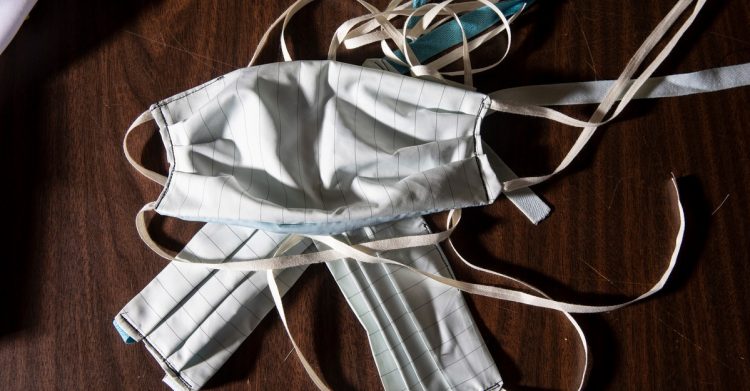Well, here we are again. After our fleeting brush with normalcy during Omicron’s retreat, another very transmissible new version of the coronavirus is on the rise—and with it, a fresh wave of vacillation between mask-donning and mask-doffing.
The Omicron offshoot BA.2 is now the dominant variant around the world and in the United States. Case counts are rising in a number of states. It’s too early to tell whether BA.2 will cause a major spike in cases here like it recently did in Europe, but that possibility is worth preparing for by having good masks on hand—and being mentally ready to put them on again.
If the thought of re-masking feels exasperating to you, you’re not alone. As Katherine J. Wu has pointed out in The Atlantic, many people just don’t care that much about COVID-19 anymore, let alone BA.2. Most Americans are no longer required to wear masks in indoor public spaces (though in some places, masks are still mandatory in crowded settings such as hospitals and prisons). People who are vaccinated and boosted are hugely protected from severe illness. Making the most of this recent reprieve, I did something I’d dreamed of since the beginning of the pandemic: screamed my lungs out in a tiny karaoke booth with unmasked friends and didn’t think twice about it. It was awesome.
But as much as I want to hold tight to that freedom, I also really don’t want to get sick again. As I’ve learned firsthand, having COVID can be miserable, even for the healthy and vaccinated, and long COVID is still a frightening possibility, as is inadvertently infecting my aging parents. Masking remains an effective and easy way to avoid getting sick whenever your risk of getting COVID increases, whether that’s because of a menacing new variant, an uptick in cases in your town, or thousands of unmasked strangers sharing a concert venue with you. So how do you know when it’s time to start again?
The answer will be different for everyone. “I get that people are fatigued, and I get that it’s cumbersome,” George Rutherford, an epidemiologist at UC San Francisco, told me. But people need to make decisions based on their own risk, which can vary greatly, depending on who you are and where you live, he said. Tom Murray, an associate professor specializing in infectious diseases at the Yale University School of Medicine, agrees. “Like all things COVID, it’s not a straightforward yes or no answer,” he told me. “It’s an individualized decision.”
Every uptick in risk, at the individual or community level, is an argument for wearing a mask. In general, your chances of getting seriously sick from COVID are higher if you’re of an advanced age, immunocompromised, living with certain medical conditions, unvaccinated, or un-boosted. Community-level risk goes up when local case counts, hospitalizations, and test positivity rates rise.
The latest CDC guidance on masking, from February, also depends on both personal vulnerability and the level of COVID in a community. The agency calculates community risk for each U.S. county daily based on local COVID-related hospital admissions, hospital-bed occupancy, and new cases, and its rubric is much more lenient than it was last year. People in low-risk counties, which are green on the CDC’s color-coded map, are not instructed to mask or not mask—they can do whatever feels right. Yellow means that people at high risk of severe illness should talk with their medical provider about wearing a mask. In red counties, indoor masking is recommended across the board. As of publication, the map is mostly green (95.6 percent of counties) with blotches of yellow (3.8 percent) and specks of red (0.6 percent). By the old metrics, universal masking would have been recommended in at least 22 percent of counties.
The new system has received mixed reviews from epidemiologists and public-health experts. Murray commended the color-coded map, and Rutherford called the new guidance “straightforward advice that gets right to the core of it.” However, it has its drawbacks. The agency’s formulas might underestimate a given county’s risk, for example. Yonatan Grad, an assistant professor of immunology and infectious diseases at the Harvard T. H. Chan School of Public Health, told me that he worries about relying on case counts and hospitalizations—the former because many people are self-testing and not reporting their results to local health authorities, and the latter because hospitalizations reflect how the virus was spreading weeks ago, not now. (The CDC did not respond to requests for comment.)
Other experts have argued that the new guidance, with its focus on individual rather than collective behavior, puts an additional burden on high-risk people, who are especially vulnerable if others around them choose not to mask. In light of this, people who are high-risk should use N95 masks, because they’re specifically designed to protect the wearer, Murray noted.
Although the CDC recommendations are a useful framework for thinking about masking when no broader policies are in effect, ultimately, the decision to mask is a personal one, experts told me. Regardless of your county’s risk level, Murray said, “if you’re most comfortable and feel safest wearing a mask, you should definitely wear a mask. It’s not harmful.” Grad argued that masking could be made as convenient as possible by ensuring high-quality N95 masks are widely available. (The CDC has an online tool for finding free ones.)
But the decision to mask can still be an uncomfortable one. Much as you might try to be consistent with your personal masking preferences, in reality, people’s perceptions of risk can change depending on the social context. I’ve shown up to parties wearing a mask, then sheepishly removed it because nobody else was wearing one. On the flip side, I’ve felt pressured to put on a mask at concerts where the crowd generally seemed more cautious, even if I felt safe because vaccination cards were checked at the door. When I’m stressed about deciding whether to put on a mask, I remind myself that it’s just one of many precautions that can be layered to help reduce risk, along with testing before gathering and opting to socialize outdoors.
This isn’t the last time that a spike in COVID risk will prompt uncertainty about masking. Many epidemiologists believe that risk levels will fluctuate year after year, as new variants emerge and cases surge alongside colds and the flu each respiratory-virus season. Since mandates seem to be less and less likely, Americans need to get used to making informed decisions about masking for themselves. That will take time. “I do think we’re seeing the transition from pandemic to endemic COVID, and the policies are really starting to reflect that,” Murray said. So long as COVID remains unpredictable, however, “there may be situations where broader masking policies would again make sense,” Grad said.
Like all transitions, this is an awkward one, and we’ll likely have to endure many more moments of masking faux pas before we fine-tune what we’re comfortable with as a society. Masking, Grad said, is something “we should work to normalize so that people can feel free to make the decision to mask when they feel like it is important to them.” That will be a tall order in the U.S., where masking has become needlessly polarized. But in many parts of the world, people don masks every virus season without much prompting from officials. Maybe, even here, reason—or at least the desire not to get sick—will eventually prevail.
Source by www.theatlantic.com


